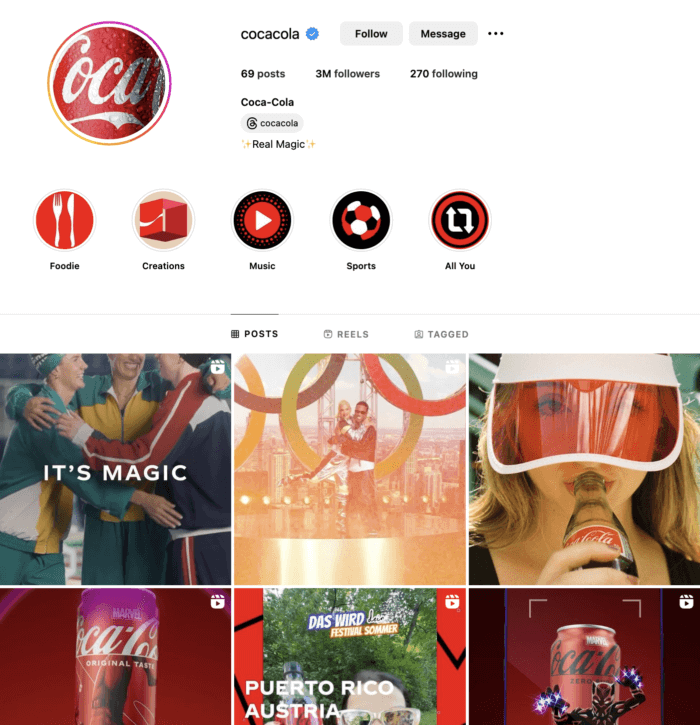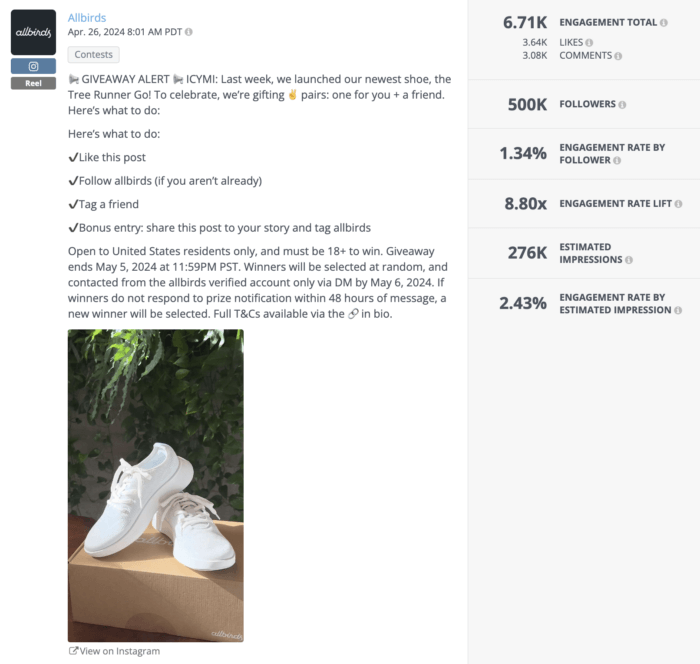Whether it’s Nike’s iconic swoosh or that colorful G that represents Google, the top brands are instantly recognizable at a glance — including on social media.
Social media branding is all about creating a consistent and engaging presence on the various social networks that you’re active on. All companies, from small startups to large corporations, can benefit from investing in their social media branding. Why? Because when done right, branding has the power to inspire trust, boost engagement, and enhance your overall brand image. Here’s what you need to know.
What is Social Media Branding?
Social media branding involves establishing and promoting a consistent image and identity for your business on social media. The goal here is to create a recognizable online presence that reflects your brand’s values, personality, and mission, as well as engages your target market.
There are three essential components to social media branding. The first is your visual identity. This includes visual elements like your logo, color palette, fonts, and overall design aesthetic. Your visual identity should help your audience recognize your brand across platforms. For instance, Coca-Cola uses its logo and signature red to make its profile and posts immediately identifiable.

Your brand voice is also important. This is the unique way that your brand communicates, reflecting your brand’s personality and values. Is your brand lighthearted and fun, or serious and professional? Whatever you choose, your brand voice should be consistent and resonate with your audience.
Duolingo, for example, is beloved for its playful and quirky voice, which is reflected throughout its content and even in its TikTok bio: “just an owl tryna vibe.”

Finally, we’ve got your brand values. These are the principles and beliefs that guide your business. Communicating these on social media helps you connect with like-minded followers.
Take Patagonia. Its commitment to environmental sustainability is a core value that it frequently highlights in its social media posts, strengthening its brand identity and appeal to eco-conscious consumers.

Together, these elements work to create a cohesive online presence. This unified branding helps your audience instantly recognize you, understand what you stand for, and connect with you on a deeper level.
The goal here is to build a community around your brand. When customers feel a personal connection to you, they’re more likely to remain loyal and make repeat purchases. Because social media branding helps you showcase your brand’s unique personality and values, it makes it easier for customers to recognize and choose you over others.
5 Tips for Successful Social Media Branding
Building a strong social media presence isn’t reserved for the brands. With the right approach, it’s entirely achievable for any business out there. Here are five tips to help you create a memorable and impactful social media brand.
1. Know Your Audience
Yes, we know we talked a lot about how social media branding is centered around your brand’s identity — but we can’t just leave your customers out of the equation!
Take the time to conduct a social media audience analysis. This involves researching and analyzing your audience’s demographics, interests, and behaviors, which will help you create content that resonates with them and meets their needs.
Social analytics tools can also be used to track your audience’s engagement with existing content. Pay attention to which types of posts get the most likes, comments, and shares, and use this data to inform your strategy. By understanding the kind of content your audience likes, you can optimize your branding and content to match their preferences.
Check out this analysis of Instagram posts from schools in the Big 12, for example. Within the past month, Brigham Young University, the focus brand here, posted only Reels. Interestingly, though, the post type that generated the highest engagement among the Big 12 was actually carousels. Armed with this kind of info, BYU could tweak its content strategy to include more of what its target audience finds engaging. Voilà, the power of data-driven insights.

2. Be Consistent
Consistency is one of the most important elements of effective social media branding as it helps build brand recognition and trust. Your audience should be able to recognize your brand across all social media channels at a glance. This means using similar visuals and tone of voice in your posts.
To achieve this, create a style guide for your brand. Outline the fonts, colors, and imagery you’ll use. Define your brand’s voice — whether it’s professional, casual, or playful — and stick to it. Keeping a consistent posting schedule will also help to keep your audience engaged and regularly reinforce your brand message.
3. Stay Authentic
Want to build a genuine connection with your audience? Authenticity is key. Social media, in particular, is seeing a major shift, with overly polished or staged posts quickly being pushed to the side in favor of natural and genuine content.
People are drawn to and more likely to engage with brands that are real and transparent. Be honest about your brand’s mission. Share behind-the-scenes content, tell your brand’s story, and show the human side of your business. All in all, don’t be afraid to show that there are real people behind your brand who share the same values, passions, humor, etc. as your followers.
4. Provide Value
Your social media account shouldn’t be just about promoting your products or services — it should also provide value. This can be in the form of educational content, inspiration, or even just entertainment.
For example, rather than just showing off their products with flashy editorial-style content, beauty brands often create helpful content like makeup tutorials or product swatches. The post below by e.l.f. Cosmetics is a perfect example of how makeup lovers positively respond to this, with the TikTok achieving an engagement rate by follower that’s more than double the median for top beauty brands.

To add value, simply think about what your audience needs and how you can help them. Create content that solves problems, answers questions, or simply makes your followers smile. When you consistently provide value, your audience will keep coming back for more and be more likely to engage with and share your content.
5. Engage with Your Audience
Social media offers brands the unique opportunity to engage with their audience, so don’t hesitate to take advantage of it. Responding to comments, messages, and mentions shows that you value your followers and appreciate their interaction. Engaging with your audience can also provide valuable insights into their preferences and opinions.
Try creating content that encourages interaction, such as asking questions, running polls, and hosting giveaways. The more you engage with your audience, the stronger your relationship with them will become, leading to greater brand loyalty and advocacy.
Top sustainable brand Allbirds has mastered this with its easy-to-understand giveaways that always bring in an influx of excited interactions. A recent campaign in honor of the new Allbirds Tree Runner Go shoe earned an impressive engagement rate by follower of 1.34%. That’s nearly 6x higher than the average engagement rate of the retail industry on Instagram.

Measuring Your Social Media Branding Efforts
So, you’ve put in the hard work to build your brand on social media — but how do you know if it’s paying off? Let’s dive into some key metrics that will help you gauge your success and fine-tune your strategy for even better results:
- Engagement: Engagement metrics, including likes, comments, shares, and overall engagement rate, are a reflection of how well your content resonates with your audience. High engagement numbers indicate strong audience interaction and interest in your brand. Regularly monitor these metrics to understand which types of content perform best so that you can adjust your strategy accordingly.
Find out what is a good engagement rate on social media. 
- Reach: Reach measures the total number of unique social media users who see your content. This metric helps you understand the potential audience size and how far your content is spreading. A growing reach means more people are seeing your brand’s posts, leading to greater brand awareness.
- Followers: Tracking follower growth over time helps you understand how well your brand is attracting and keeping an audience. Of course, it’s not just about the numbers; quality matters too. Be sure that your followers align with your target audience to keep things on track.
- Mentions: Brand mentions, both tagged and untagged, provide insight into how often and in what context people are talking about your brand. Social listening tools can track these mentions across various platforms, giving you valuable insights into your brand’s visibility and reputation.
Of course, managing all these social media metrics for your different accounts can get a bit overwhelming, which is why so many brands work with a social analytics platform. By consolidating the performance data from all your accounts, these tools make it easy to see the big picture.
See how your social media brand stacks up. 
With Rival IQ, you can see your data in easy-to-understand charts and graphs alongside helpful insights that our platform automatically draws. Plus, we add competitive context to your metrics so you can learn from your peers and see how you stack up against others in your industry. Check out a sample dashboard below.
Wrapping It Up
As social media gets more saturated with businesses each day, effective branding could be your ticket to standing out. Each photo, video, and comment contributes to your brand’s unique story. Be consistent in your efforts and you’ll be well on your way to a recognizable and trustworthy online presence. Just don’t forget to measure, analyze, and optimize your efforts. Doing so will allow you to make data-driven decisions and stay ahead of the competition for the long term.
